Rules of Combat
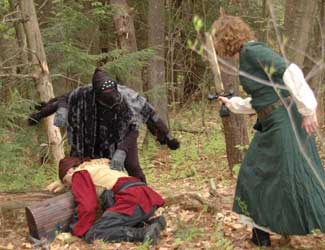
Conduct in Combat
Participation
In order to take part in Quest activities, all participants must be eighteen years of age. They must agree to follow Quest's rules and conventions. Refusal to do so, or deliberate flouting of these rules, is grounds for being banned from Quest combat and from all other Quest activities.
Safety Words
The primary safety words used to regulate combat are "Hold," "Freeze" and "Lay on."
- Hold is used to stop all combat and action. Upon hearing the world "hold" all players must immediately cease activity and kneel until the lay on command is given.
- Freeze is used if a local stop is required for a rules dispute, minor injury, etc., that does not require stopping all action. There is no "moving through" a frozen zone; if someone outside the zone enters it, they must stay until the issue is resolved. Anyone within the zone may call a general hold if they believe the freeze will be unfair to one side or the other.
- Lay on resumes activity after a hold or freeze. Only the person who called the hold or freeze may dictate the lay on.
Self-Control
All participants must maintain control of themselves and their tempers when on the field and remove themselves from a combat situation if they become angry.
Temporary Bans
The Weapons Manager or designated Weapons Marshals may, at any time, pull a participant from fighting and issue a temporary ban from Quest combat. This may be done for either safety or health reasons. A temporary ban may last for no more than one day. A ban may be appealed to the Weapons Manager, but his or her decision is final for the duration of the event. Quest may issue a permanent ban from Quest events.
Permanent Bans
The Weapons Manager may, at his or her discretion, issue either written or verbal Formal Warnings to a participant for unsafe fighting. Three Formal Warnings in the space of one year automatically result in a permanent ban. Permanent bans may only be lifted by the Board of Directors. A participant has the right to bring any grievances regarding Quest procedures or officers to the Board of Directors.
Combat Courtesies
Lighting
You may not intentionally position yourself so as to direct sunlight or other bright light into an opponent's eyes.
In addition, participants are not to fight in poorly lit areas, particularly at night. If combat ensues in a darkened area, the combatants should all go out-of-game, move to a sufficiently lit area, and then continue the combat.
Corkscrewing
You may not "corkscrew" an opponent who is on their knees. This means that you should not circle such an opponent repeatedly, forcing them to move painfully about on their knees.
Exception: during a line battle, you may freely circle around a line of fighters (and their support).
Courtesy Strike
You should not hit someone full strength if the target does not have a weapon, cannot defend against you, or seems to be unaware of your presence. Instead of hitting the target full force, deliver a light version of the strike you might otherwise have performed. Then indicate that you intended that to be a killing blow by stating "courtesy strike." Each time you hit the target that way, it counts as a single good blow. Since the target may have magical protection, you may wish to "hit" them several times. In this case, you are required to say "courtesy strike" on the first hit, but you are only required to say "strike" on the subsequent hits.
You may not use Courtesy Strike if you could not have delivered a blow at full calibration.
If someone performs a Courtesy Strike upon you, you must take the strike as a good hit so long as it was possible for the person to deliver a killing blow on you at that time.
Note: do not use Courtesy Strike while you are engaged in a melee with someone. If the target is aware of you and taking defensive action, strike them normally.
Note: failure to use Courtesy Strike on someone who obviously cannot take defensive action is considered over-calibration, and will be dealt with by the Weapons Marshals accordingly.
Multiple Opponents
No more than four opponents may fight one person at a time. Any more than this is unsafe and makes the solitary fighter get "battered" unnecessarily.
Exception: when attacking a line of fighters (and their support), the restriction on multiple opponents does not apply. A line is considered to be a single entity, so everyone in a line may attack freely.
Blow Recognition
Even when role-playing, it is a good idea to let your opponent know which blows were good and which were not. Saying "Hah, you only broke the skin" can prevent a lot of conflicts later on.
Addressing Problems
If you're having problems with any part of an opponent's fighting style—blow strength, blow calibration, blow delivery, etc., tell them so in a prompt and courteous manner. Instead of saying "That &@$#-ing blow was too hard!" try, "Ow! Could you please lighten your blows?" Instead of "That blow was &@$#-ing good, you rhino!" try "Was that blow good?"
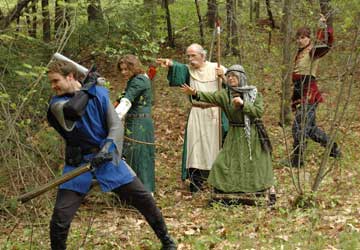
Striking a Blow
Legal Target Areas
Legal target areas for combat shall be from the ankle bone on up the leg, from the wrist bone on up the arm, and from the neck on down. The head, hands, and feet are not legal target areas and blows landed there do no count. (Exception: Stun Bolts, Lightning Bolts, and Holy Bolts may be legally targeted at these areas and do count. However, these must be thrown underhand to be valid.)
- Participants are prohibited from deliberately striking the neck or crotch area, but if a blow does land there by chance it is to be taken according to its merits (light, killing, etc.).
- An accidental head shot will result in an immediate local hold (freeze) between the fighters involved until the recipient signals that they are ready to lay on.
- Three head shots in the same combat causes the offender to forfeit the fight.
- Athletic cups for men and sports glasses for all who wear glasses are highly recommended, but not required at this time.
Blow Calibration
All participants are to maintain their blows at a level judged "good" but are not to put any more force into them than is necessary for the blows to be judged good. Furthermore, all weapons shall be used in accordance with the rules of their class.
Arc Of Swing
In general, no weapon may be power-swung through more than 120 degrees of arc, and no great or pole weapon may be power-swung through more than 90 degrees of arc. If a thrusting tip is used, it may not be used with a full-force lunge, nor may the elbow be locked at any time during a thrust.
Thrusting
A participant has the right to request that an opponent stop using a thrusting tip if several of the thrusts have gone wild, particularly towards the face, or if the participant has reason to believe that the tip is being used in an unsafe manner.
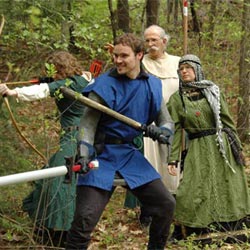
Effects of Blows and Wounds
Judging Blow Effectiveness
All participants will maintain an experiential knowledge of what constitutes a good blow and will promptly and courteously inform an opponent if their blows are consistently too heavy or too light. When struck by a blow, you will take into account:
- the type of weapon that struck
- the force of the blow
- the location of the blow
- any obstructions the weapon encountered, such as other weapons, shields, branches, etc.
- any armor worn
- any protective spells the target may have
From these criteria, you then judge whether the blow was good or not. If the blow was good, you immediately take its effects.
For safety reasons, stabbing weapons and projectiles should strike much more lightly than other weapons. This amount of force should be treated as enough to cause damage; it would be unsafe for these weapons to strike with the force of a normal blow.
Acknowledging Ineffective Blows
If a participant receives a blow that would otherwise be good, but which was nullified by one of the above conditions, the target of the blow will promptly and courteously let their opponent know why it was not good.
If the blow was light, the target should at least say "light," or otherwise verbally acknowledge that the blow was not sufficiently solid.
If the blow was negated because of protection (armor or magical protection), the target must at least state "protection" to acknowledge that the blow was good but has been negated. The target need only say "protection" and need not tell the opponent the nature of the protection.
If the blow had absolutely no effect (not even removing protection), and further identical blows will have no effect as well, the target should at least state "no effect" or otherwise verbally acknowledge that the blow did no damage at all.
Various forms of protection and defensive spells and abilities may be used at the same time; these include (but are not limited to): magical protection (Barkskin and Stoneskin); natural protection (Toughness); normal protection (armor); the skills of Will, Immunity to Poison, and Exceptional Strength; and the spells of Magic Absorption, Poison Absorption, Iron Will, Strengthen Will, Spell Immunity, and Strong Grip. It is completely up to individual players to choose which will absorb any blow or spell aimed at them.
If a combatant falls to the ground forgetting that they have protection, that protection does not count, and they are judged to be dead, regardless of the number of hits that they could have absorbed had they remembered the protection.
Protection
Protection allows characters to ignore the effects of a specified number of sword blows (and some magical spells). When hit, they must explain this by announcing that they can absorb the blow or spell due to protection. For example, they might say, "protection," or perhaps, "Hah! Your sword bounces off my armor!"
One way to gain protection is through armor. Armor protects only the areas that it covers and regenerates after each combat or encounter. For example, suppose that during a battle, your armor absorbs its full capacity, but then your party dispatches the foes. If you encounter more enemies five minutes later, then your armor will once again be fully effective.
Another way to gain protection is through magical protection spells (Barkskin and Stoneskin). Magical protection covers the entire body, but does not regenerate: after being used, it is gone. Protection spells are noncumulative and are incompatible with one another—you cannot have more than one protection spell at a time.
In addition, certain races can have "Toughness," which simulates a creature's natural defenses, such as scales or a tough hide. This type of protection covers the entire body and regenerates after each combat or encounter. It is very rare for PC races to have this ability; normally Toughness is used by large animals, monsters, and undead.
Safe
The Safe spells (like Safe Retreat) provide complete immunity from blows and spells. (See the section on Safe spells.)
Role-Playing Wounds
Participants are expected to role-play wounds as if they have been caused by real weapons. This does not always mean that a limb, for example, has been hacked off. However, a good blow will always cause the limb to be useless for combat purposes. If the blow was one of sufficient strength, the player may decide that it has been removed, but this is a personal judgment.
Limb Wounds
A good blow to an arm removes the use of that arm. If it was a weapon arm, the weapon may be shifted to a free hand, if available. Otherwise, the weapon falls to the ground. If the blow is to a shield arm, the shield may be dropped or allowed to dangle, as the player chooses, but it may not be moved consciously in any way. The arm is useless.
A good blow to a leg removes the use of the leg. You may, if desired, hop twice to remove yourself from danger or to a better position, but after that you must go down on your knees and crawl or knee-walk from then on.
After you receive three limb wounds, you fall unconscious. If you have three bleeding limbs (that is, none of your three wounds get bandaged or tended to), you begin critical bleeding (see below).
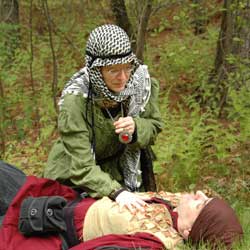
Torso Wounds
After you receive a good blow to the torso, you fall unconscious. A bleeding torso wound causes critical bleeding (see below).
At the victim's discretion, a torso wound may be instantaneously fatal (e.g., heart, lung, neck, or spine wounds).
Critical Bleeding
Once you begin bleeding critically, you will die in two minutes unless you receive First Aid or healing.
Merely stopping the bleeding of an unconscious person will not revive them; all but two limbs must be healed before they reawaken.
Example: Ethward the Incompetent is gut-shot by an arrow. He immediately falls unconscious. His party drives off the archer; it has been about a minute since he fell. Ethward is pale and slipping fast, but still alive. The party's priest uses healing magic and Ethward's life is saved. Later, however, the party tangles with an ogre who sinks good blows into both of Ethward's legs and one of his arms. Ethward once again falls. The ogre continues to battle the party for almost five minutes before they kill him. By that time Ethward is a cold corpse. His party raises him, however, and they continue on. Out jumps a thief, who plants his dagger full to the hilt in Ethward's incompetent heart. The thief is slain within seconds, but the wound was immediately fatal and Ethward is once again dead. His party refuses to waste more magic on the wretch, and his soul floats off to the GMs to learn its fate, while his body is food for foxes and vultures.
Unspecified Wounds
Characters may end up taking wounds from traps, spells, or other game effects that do not explicitly specify the region to be struck. For instance, a trap may say that the trap inflicts "two limb wounds" on its victim. If the target area is not specified, it is up to the victim to choose which regions are affected, but the victim should pick areas that are not already wounded.
Instant Death
If your character has a weapon of some sort, you may elect to slay an unconscious body. This is done by holding the weapon to the chest or neck of the person you wish to slay and indicating that you are performing "Instant Death." If the character is not interrupted for 10 seconds, then the formerly unconscious body is now dead. You may not perform Instant Death upon a conscious person under any circumstances. Performing Instant Death takes concentration and cannot be performed while you are defending yourself, nor can it be performed "as your last act" as you slip into unconsciousness.
Although it actually takes quite a while to kill someone with medieval technology, this rule is provided for dramatic effect. Also note that performing Instant Death is quite gruesome and is generally frowned upon.
Death
Dead characters should remain in place (this is called "role-playing a corpse") until the battle ends. Exception: if a corpse is in the way and creating a safety hazard, a hold or freeze should be called so that the corpse-player can move.
Nonlethal Combat
Hand-to-Hand (Brawling)
Initiation
To begin a brawl, the initiator touches the victim and declares "brawling." Once a brawl has begun, the two are compelled to at least one contest (see below), even if the victim already has a weapon drawn.
No more than two persons may be involved in a single brawl at one time, but one person may be involved in multiple brawls at once!
Conduct
Each combatant declares their level of Brawling. The person with the higher level wins all ties in "paper-scissors-rock." (If there's a tie and the Brawling levels are the same, the contest ends with no one being hit.)
The two then conduct a contest of paper-scissors-rock. The winner delivers a blow to the loser. If, within a five-minute period, anyone receives a number of blows equal to 3 plus their Brawling level, they are knocked unconscious for five minutes.
If one person flees, the other person may chase and, if they tag the fleeing party, may initiate a new contest.
Defense
Protection (armor or magical protection) will absorb three punches per hit of protection. For example, three punches will cancel out leather armor or a Barkskin but leave the person untouched. Two-hit armor or Stoneskin will absorb six blows.
("Leftover" fractions against magical protection are ignored once the combat ends. For instance, if you have a Barkskin and take one hit during a brawl, this blow is ignored once the combat ends and your Barkskin will be intact. If you later enter another brawl, you will need three, not two, hits to cancel the Barkskin.)
Subdual
In combat, a player may choose to cause only temporary, rather than lethal or permanent, damage. This is known as "fighting to subdue." In real combat, this would be caused by hitting with the flat of the sword, leaving the sheath on, hilt-bashing, using blunt-tipped arrows, etc. (However, none of these things are really Quest-safe.)
Subdual hits work as normal, except:
- They don't cause critical bleeding. You will still fall unconscious when you take enough wounds.
- If you go for five minutes without taking any more subdual hits, the damage ends and you fully recover from all subdual wounds.
- The Revive spell will heal all subdual wounds.
- You must call "Subdual" as you strike.
A subdual strike can be combined with a Courtesy Strike to disable someone who is unaware of your presence. To do this, strike your opponent lightly on the back (as with a regular Courtesy Strike), and say, "subdual courtesy strike." If you wish to strike them more than one time (in case they have magical protection, for example), you need only say "strike" on subsequent hits.
Characters with the Stealth skill may subdue opponents by sneaking up on someone, and waving their Stealth Card in front of their opponent's face. This action is the equivalent of a subdual Courtesy Strike to the torso. This type of subdual is sometimes referred to as "sapping."
To perform multiple saps, move the Stealth Card rapidly up and down from the elbow. Each time it crosses the victim's eyes, it is considered another hit. Armor (including a full helm covering both the neck and head) and magical protection both work automatically against sapping.
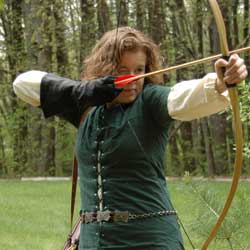
Archery
Playing an Archer
Archers are subject to a number of rules and customs due to the fact that they cannot always control where their arrows will strike. Before a player uses a bow in combat, they must be trained in its use. Archers are trained to aim at backs in preference to fronts, legs and arms in preference to chests. This is to minimize the danger of an arrow going into the face. While we have never had a serious injury, face shots are uncomfortable and all players and archers must work together to keep things as safe as possible.
Archer Responsibilities
- To see that all equipment is in good repair, and to constantly inspect all arrows for signs of wear.
- To immediately break any arrow that is unsafe and cannot be repaired.
- To refrain from shooting if they do not have a safe target.
- Not to shoot at night unless in a well-lit area or under an exceptionally bright moon.
- To shoot at less-easily injured parts of the body in preference to shots which could conceivably hit the face.
- To vary the draw of their arrows so as to put only the amount of force in them necessary to reach the target.
Player Responsibilities
- To be aware of and try to avoid "ducking into" a shot, and to try to keep shields angled in such a way that arrows are deflected down, not up.
- To avoid stepping on arrows, and to toss them to a safer place if they are in harm's way.
- To save broken arrows, or to at least save the arrow tips (since the tips are the hardest to make or replace).
Getting Hit By An Arrow
In the interest of safety, our arrows fly much slower and hit much softer than a real arrow would. To keep things fair for the archers, these rules apply when you are hit:
- There are no light hits from arrows. Even if an arrow hits a padded part of your costume such as your cloak, it still counts as a hit. Similarly, arrows that ricochet off of the ground, a wall or a shield still hit.
- You cannot bat or parry an arrow with a weapon; you can only block an arrow with a shield. To discourage the parrying of arrows, if an arrow strikes a weapon in hand, the weapon must be dropped immediately, even if the player has Strong Grip or Exceptional Strength.
- Do not use your arm as a "living shield" so that the arrow hits your arm rather than your torso. If your arm is in front of your torso and is hit by an arrow, the arrow is considered to have hit both the arm and the torso. (Only standard arrows and bolts do this damage, not darts or similar projectiles.)
- In many cultures, shooting someone in the back is considered dishonorable. However, since getting hit with a prop arrow in the back is much safer than getting hit in the front, we want to encourage back shots. So under our rules, shots to the back are not considered dishonorable.
Arrow Gathering
Only archers may pick up arrows. A non-archer may toss one to a safer place, or may pick one up to deliver it immediately to an archer friend. Non-archers may not gather up arrows to keep them out of archers' hands. (The reason for this rule is that a military quiver would hold 36 bodkin-pointed arrows, while the average Quest quiver is bursting with 6 or so.)
Arrows are semi-common property among archers. You may take someone else's arrows. However, if the archer is dead, they must be given at least two and preferably four arrows to go to the resurrection point with.
Example: Fred the archer sees Mike the archer, and fires all four of his arrows at Mike. Mike, who has not fired any of his own arrows, picks up all of Fred's and waves goodbye, leaving Fred with no arrows. This is legal. Later, Fred and Mike meet again. Fred has found an arrow somewhere and kills Mike with it. Mike has ten arrows in his quiver. Fred may loot Mike's body of six of them, leaving Mike's corpse with four.
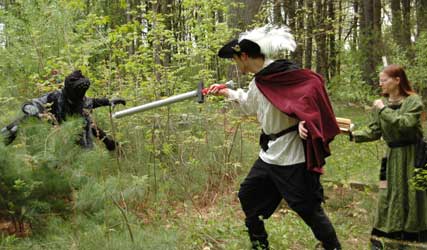
Equipment
Color Codes
Weapons are color-coded according to their game effects and the method in which they may be used:
White: Thrusting
A white sword sock indicates that a weapon has been judged safe for thrusting by a Weapons Marshal. Thrusting with any weapon that is not marked with white, even if the attack does not hit, is illegal.
Exception: weapons without a hard core (such as daggers, which are made only from foam) may be used for thrusting even if not white, provided the weapon is so approved.
Black: Swinging only
Black weapons are not safe for thrusting actions and may never be used in such a manner. They may only be swung.
Green: Poison
A weapon that is green or bears green tape is poisoned. (See the section on Poison on page 61.)
If you are hit with a poisoned weapon, you will be poisoned. Even a light scratch is enough. Blows absorbed by protection (and light hits taken while you have protection left) will not poison you.
Blue: Magic
A magic sword penetrates protection extra effectively (so treat a magical sword blow as two blows from a normal sword for this purpose). A light blow from a magic sword is good. A scratch burns like fire.
A magic weapon should be role-played as hitting harder and causing more damage than it otherwise would. A magical weapon is more difficult to parry—try to role-play this.
Standard magic swords are immune to offensive spells such as Drop Item, Fling Item, Heat Item, and Heat Metal, and will harmlessly absorb Touch and Missile range spells that hit them. They also resist all damage that can normally be inflicted by a PC. Specific magic weapons may also have specific powers, detailed on a note on the weapon.
Arrows (or other projectiles) fired from a magic bow (or other launcher) will do damage as if they were magic weapons, but will not themselves be enchanted (e.g., they will not be considered magic weapons if picked up and re-used by another launcher).
Yellow: Throwing
Yellow tape indicates a weapon that has been approved safe for throwing. Characters with the Throw Weapon skill may throw these weapons; they do damage no matter what part of them actually hits the target. No unmarked weapons may be thrown under any circumstances. As projectiles, thrown weapons do damage even if they hit lightly.
Gold: Holy
A holy weapon acts like a blue-sock magic weapon, but only against undead and unholy beings. To everyone else, it acts like a normal weapon (and can thus be affected by their spells).
Just as magic weapons resist offensive spells, holy weapons resist those same spells, but only when those spells are cast by the undead or unholy.
Other
Other colors may have other meanings, depending upon the event. The GMs will notify you if this is true. You may not place other colors on your sword unless given the right to do so by the GM or the game plot.
Terminology
Projectiles
Arrows, crossbow bolts, thrown weapons, and other free-flying weapons are referred to as "projectiles."
